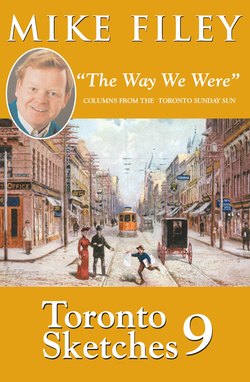Читать книгу Toronto Sketches 9 - Mike Filey - Страница 9
ОглавлениеBright, Shiny, and New
Almost without exception this column features an “ancient” photograph more often than not taken by some anonymous photographer. To be sure, where the identity of the person who took the picture is known the work is credited. Unfortunately, the passage of time since the photo was snapped usually precludes that possibility.
The matter of photo credits aside, in almost every instance where there are buildings in the old photograph, the vast majority of those structures has been demolished as a result of Toronto’s rush to replace what many regarded as passé, with things bright, shiny, and new.
One conclusion that might be drawn from all of this is that any photo containing an image of a building that no longer stands must have been taken by an old (or deceased) photographer. With this in mind you can imagine my consternation as I went through a bunch of photographs that I personally took since acquiring my interest in old Toronto some years ago. Many of those views showed buildings that are no more. Can it be that my stuff is also “ancient”? Is it possible that I am getting old? Or am I just older?
While I sit back and ponder my future I offer for your perusal a quartet of my “ancient” photos.
January 26, 2003
The University Theatre stood on the north side of Bloor Street between Bellair Street and Avenue Road. This was one of the first major motion picture palaces to be erected following the end of the Second World War in 1945. The 1,556-seat theatre’s official opening was postponed several times owing to the shortage of structural steel that had been diverted for use in the construction of electrical generating stations around the province. This same shortage resulted in the delayed opening of the Toronto-Barrie highway (now 400) and the Toronto Bypass Highway (now 401). The University finally opened in 1949 and was one of the city’s most popular movie houses until its closure in 1986. At that time there were plans to incorporate a portion of the theatre as well as the theatre facade in the new development planned for the site. Unfortunately, the curtain never went up on this interesting proposal. The marquee reveals that the feature presentation at the theatre when I took this picture in 1979 was Apocalypse Now.
When I was a kid, this imposing structure was usually referred to rather disparagingly as “999 Queen Street.” Built between 1846 and 1858, the Provincial Lunatic Asylum was regarded as one of the most modern treatment facilities for the mentally ill anywhere in the world. Unfortunately, the stigma of what went on inside the asylum precluded the building having any future. And while pleas were made to at least save certain architecturally significant portions of the complex (the massive dome, for instance), the whole thing came crashing down in 1975. The Queen Street Mental Health Centre now occupies the site.
While on the subject of unimposing buildings (actually this structure still stands or was standing when I wrote this article), this building at the southeast corner of Dupont Street and Westmoreland Avenue is where Torontonian Norman Breakey perfected his Koton Koter in the early 1940s. Where who perfected his what? Norman Breakey was the inventor of the paint roller that Eaton’s and Simpson’s sold under the name Koton Koter for $1.98. Following a typically Canadian scenario, Norman wasn’t able to raise sufficient funds to protect his invention and soon variations of his creation had flooded the market, leaving poor Mr. Breakey as a might-have-been millionaire.
Constructed in the early 1900s to house the “Northern” branch of the Traders’ Bank of Canada, this imposing building on the northeast corner of Yonge and Bloor became a branch of the Royal Bank when the latter took over the former in 1912. It was demolished to clear the way for the unimposing Hudson’s Bay Centre that opened in 1974.
